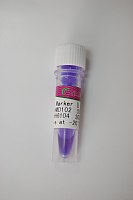Chemical Cleavage of Mismatch (CCM) is one of the methods of choice for mutation research and diagnosis of inherited diseases, as it is capable of detecting 100% of single-base mismatches (
1 ). The scientific background of CCM stems from the initial study of sequencing technique (
2 ) in conjunction with other advanced studies associated with thermodynamics and secondary structures of single base pair mismatched DNA or RNA (
3 ). Such literature data confirmed that the mismatch point is locally destabilized and highly susceptible to many enzymatic (
4 ,
5 ) and chemical reactions (
6 ). Based on this platform, the CCM technology theoretically establishes the simplest chemical means to detect mismatch and thus mutation at this point in time. The method employs two commercially available chemicals, hydroxylamine (
7 ) and potassium permanganate (
8 –
10 ) to react with unmatched cytosine and thymine, respectively. The modification of the mismatch is then followed by cleavage with piperidine and the resulting DNA fragments are simply analyzed by denaturing polyacrylamide gel-electrophoresis to identify the mismatch sites. Since the first protocol was described in 1988 (
11 ), the performance of this method has been continuously improved and the present protocol has some major advantages: (
1 ) potassium permanganate (KMnO
4 ) has replaced the toxic osmium tetroxide (OsO
4 ) (
9 ,
10 ); (2) if both mutant and wild-type DNA samples are labeled a double chance of mutation detection occurs; (
3 ) the method is sensitive to as low as 0.1 μg of DNA samples; (
4 ) and more importantly, all reaction steps are now being carried out on a silica bead solid support for convenient manipulation (
see Fig. 1 ).
Fig. 1. Solid-phase chemical cleavage of mismatch. Both perfect and mismatch duplexes are immobilized on silica beads. Chemical modification reactions are carried out while DNA duplexes still remain on solid support. One sample of DNA is treated with hydroxylamine and another with potassium permanganate. Piperidine treatment simultaneously cleaves the mismatched point and releases the samples for gel electrophoretic analysis.








